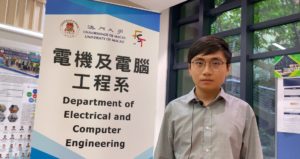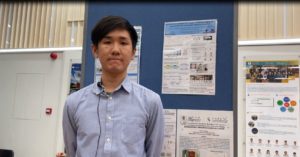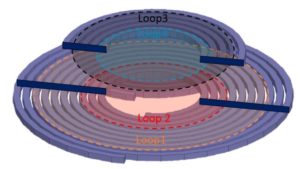With the rapid expansion of the charging market, wireless charging technology has now been widely used. However, most of the wireless charging products in the market are still using symmetrical coils for power transmission, which is a limitation for devices with limited space and also want to use wireless charging. In order to solve this problem, Leong Kin Iong and Wong Hou Wa, 2020/2021 outstanding undergraduates of the Department of Electrical and Computer Engineering, used asymmetrical coils for power transmission as the topic of their graduation project. They studied different factors such as coil size, coil spacing and coil shape in their works, and verified the effectiveness of the coil through experiments such as charging efficiency and charging current. The two finally succeeded in verifying the design theory of asymmetric coils on an automated guided vehicle (AGV). For the entire charging system, the two even designed a protection system to make the entire charging process safer.
The asymmetrical coils designed by them can achieve roughly the same efficiency as the traditional symmetrical coil. However, there are many factors that affect the efficiency of wireless charging. Therefore, it is a challenge to convert the same coil into different coils while maintaining the charging efficiency. Leong Kin Iong shares, “the biggest challenge for us is that when calculating the mutual inductance of the coil, we had used the wrong theory to calculate the asymmetric coil. The problem was not discovered until the actual measurement so we were behind schedule. Fortunately, two of us keep on working hard on finding out a more suitable theory, and we finally succeed.” In regards of the gains from the past four years in UM. Leong Kin Iong and Wong Hou Wa shares, ‘the unique college life and experiences in UM allowed students to meet people from different countries, there are many excellent academic staff, and it has state key laboratories, abundant resources and equipment, which also give students more opportunities to find out their talents.’ In the future, Leong Kin Iong will work on achieving relevant professional qualification licenses to further enhance his professions. Wong Hou Wa will study a master’s degree and participate into the world vocational skill competition to enrich his experiences.
隨著充電市場的急速擴展,現時無線充電技術已得到廣泛的應用。然而市面上大部分的無線充電產品都是使用對稱線圈進行電力傳輸,對於一些空間受限而又想引用無線充電技術的設備卻是一種限制。為了解決這個問題, 2020/2021學年的電腦及電機工程系優秀本科畢業生梁建勇及黃濠華以非對稱線圈進行電力傳輸作為畢業設計作品的題目。他們在作品中研究和測試了線圈尺寸、線圈間距和線圈形狀等因素,還透過充電效率和充電電流等實驗來驗證線圈的效能。兩人最終成功在自動導引車(AGV) 上驗證非對稱線圈的設計理論。針對整個充電系統,兩位更設計了保護系統令整個充電過程更安全。
二人設計的非對稱線圈能達到傳統對稱線圈大致相同的效率,然而影響無線充電效率的因素有很多,因此要在保持充電效率下,將相同線圈轉換為不同線圈是一個挑戰。梁建勇分享說: 「在計算線圈的互感值時我們遇到最大的挑戰,最初在計算非對稱線圈時使用了錯誤的理論,直到實測時才發現問題,以致進度落後,幸好兩人齊心協力一路堅持,最後終於找到適合的理論。」談及大學四年的收穫,梁建勇及黃濠華說: 「澳大獨一無二的書院生活和活動,令大家可以與來自世界各地的人交流,認識多元文化,更認識到一班志同道合、一起並肩作戰的朋友。」澳大師資優良,同時擁有國家重點實驗室、充沛的資源和設備,也令學生有更多機會展現才能。未來梁建勇將爭取考取相關專業資格牌照,進一步提升自己實力。黃濠華將升讀碩士,並參加世界職業技能競賽,豐富閱歷,繼續挑戰自己。
黃濠華Wong Hou Wa
梁建勇Leong Kin Iong
不對稱線圈 Asymmetrical coils




